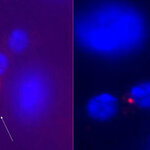Cancer Research

As evidence mounts that the body's normally protective inflammation response can drive some precancerous tissues to become fully malignant, UCSF scientists report discovering an apparent trigger to this potentially deadly process.
Typically, the "innate" immune system's Pac-Man-like white blood cells, or leukocytes, engulf and destroy invading microbes when receptors on their surface receive a signal from serum in the blood -- often an antibody produced by a B cell in the separately evolved "acquired" immune system.
Now UCSF researchers have found that in the presence of precancerous…

In almost all forms of heart failure, the heart begins to express genes that are normally only expressed in the fetal heart. Researchers have known for years that this fetal-gene reactivation happens, yet not what regulates it. Now, investigators at the University of Pennsylvania School of Medicine have discovered that an enzyme important in fetal heart-cell development regulates the enlargement of heart cells, known as cardiac hypertrophy, which is a precursor to many forms of congestive heart failure (CHF).
The study, which paves the way for new targets for treating cardiac hypertrophy…

Three years ago Mark Kay, MD, PhD, published the first results showing that a biological phenomenon called RNA interference could be an effective gene therapy technique. Since then he has used RNAi gene therapy to effectively shut down the viruses that cause hepatitis and HIV in mice.
With three human RNAi gene therapy trials now under way - two in macular degeneration and one in RSV pneumonia - the technique Kay pioneered may be among the first to find widespread use for treating human diseases. "We've worked on a gene therapeutic approach against viral hepatitis for about 10 years and this…

When cells become cancerous, they also become 100 times more likely to genetically mutate than regular cells, researchers have found. The findings may explain why cells in a tumor have so many genetic mutations, but could also be bad news for cancer treatments that target a particular gene controlling cancer malignancy.
The research was led by Dr. Lawrence Loeb, professor of pathology and biochemistry at the University of Washington School of Medicine in Seattle. Loeb will present his research Feb. 18 at the meeting of the American Association for the Advancement of Science in San Francisco…

A special cocoa made to retain naturally occurring compounds called flavonols may have the potential to help maintain healthy brain function and chart the course for future research that could lead to new solutions for preventing cognitive decline and dementia, according to a panel of scientists who presented new data at the annual meeting of the American Association for the Advancement of Science (AAAS).
Several studies suggest that consumption of a special cocoa made to be rich in flavonols, a naturally occurring nutrient abundant in fresh cocoa, may improve blood vessel function. Now,…

An international team of researchers from 19 countries has identified one gene and a previously unidentified region of another chromosome as the location of another gene that may contribute to a child's chances of having autism.
The findings, based on genetic samples from nearly 1,200 families with two or more children who have autism, were published today in Nature Genetics by more than 120 scientists from Europe and North America who make up the Autism Genome Project.
The project was launched in 2002 by scientists at 50 institutions to share data, samples and expertise in an effort to…

Imagine a cancer treatment tailored to the cells in a patient’s body, each person receiving a unique treatment program.
This is what Natural Sciences and Engineering Research Council grantee Thomas Ruth and his colleagues hope to accomplish within the next decade. Using the TRIUMF particle accelerator based in Vancouver, British Columbia, they are taking vast amounts of radioactive material and separating the particular atoms they need for therapy.
Ruth says radioisotope therapy is the next big frontier in health care because different types of chemicals can be selected for tailor-made…

From roundworm to human, most cells in an animal’s body ultimately come from stem cells. When one of these versatile, unspecialized cells divides, the resulting “daughter” cell receives instructions to differentiate into a specific cell type. In some cases this signal comes from other cells. But now, for the first time, researchers at the Carnegie Institution’s Department of Embryology have found a type of stem cell that directly determines the fate of its daughters.
Intestinal stem cells (ISCs) in the gut of the fruit fly, Drosophila melanogaster, directly determine the fate of their…

Researchers at the University of Pennsylvania School of Veterinary Medicine have derived uniparental embryonic stem cells - created from a single donor's eggs or two sperm - and, for the first time, successfully used them to repopulate a damaged organ with healthy cells in adult mice. Their findings demonstrate that single-parent stem cells can proliferate normally in an adult organ and could provide a less controversial alternative to the therapeutic cloning of embryonic stem cells.
"Creating uniparental embryonic stem cells is actually much more efficient than generating embryonic stem…

Quickly now, which is a higher risk that you will get a disease: 1 in 100; 1 in 1,000; or 1 in 10? Choosing the correct answer depends on a person's numeracy – the ability to grasp and use math and probability concepts, according to a presentation at the annual meeting of the American Association for the Advancement of Science.
The scenario was part of a series of experiments with University of Oregon students. In this case, 96 percent correctly chose 1 in 10, a 10 percent chance. However, that response came from a more-educated, college-going crowd. The numbers of correct answers fell…